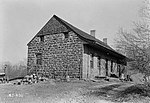River Vale, New Jersey

River Vale is a township in Bergen County, in the U.S. state of New Jersey. River Vale is the easternmost municipality in an area of the county referred to as the Pascack Valley. As of the 2020 United States census, the township's population was 9,909, an increase of 250 (+2.6%) from the 2010 census count of 9,659, which in turn reflected an increase of 210 (+2.2%) from the 9,449 counted in the 2000 census. The township was ranked #29 on the 100 Best Places to Live 2007 survey published by CNN/Money magazine.River Vale was formed as a township on April 30, 1906, from portions of both Hillsdale Township (now Hillsdale Borough) and Washington Township. The township was named for its location along the Hackensack River.On January 5, 1904, the temperature in River Vale fell to −34 °F (−37 °C), the lowest temperature ever recorded in New Jersey.
Excerpt from the Wikipedia article River Vale, New Jersey (License: CC BY-SA 3.0, Authors, Images).River Vale, New Jersey
Rehill Court,
Geographical coordinates (GPS) Address Nearby Places Show on map
Geographical coordinates (GPS)
| Latitude | Longitude |
|---|---|
| N 41.014201 ° | E -74.006774 ° |
Address
Rehill Court
Rehill Court
07675
New Jersey, United States
Open on Google Maps





